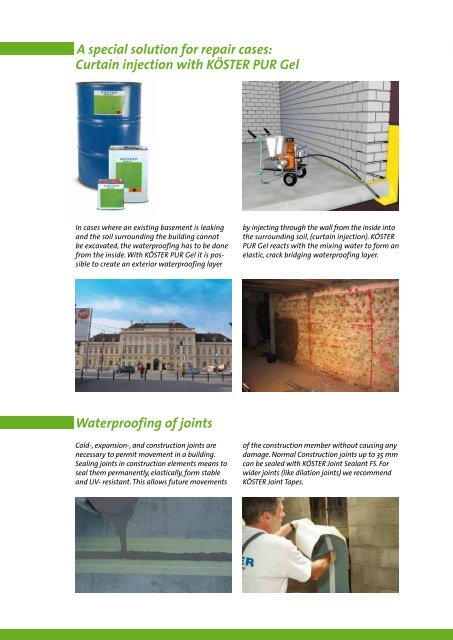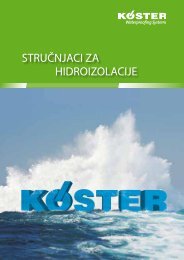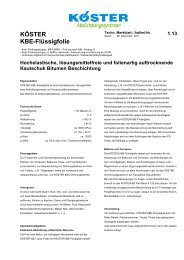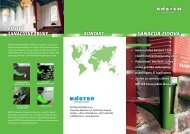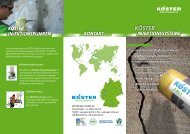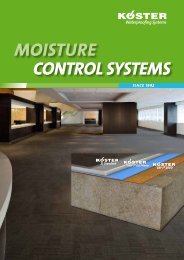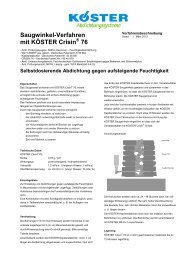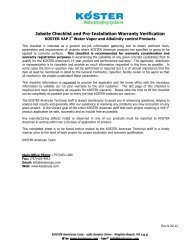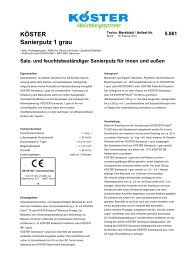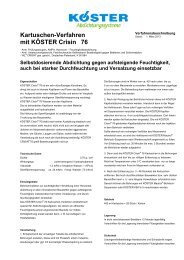External Basement Waterproofing - Koester.eu
External Basement Waterproofing - Koester.eu
External Basement Waterproofing - Koester.eu
You also want an ePaper? Increase the reach of your titles
YUMPU automatically turns print PDFs into web optimized ePapers that Google loves.
A special solution for repair cases:<br />
Curtain injection with KÖSTER PUR Gel<br />
Surface preparation<br />
All surfaces have to be prepared before they<br />
receive a waterproofing layer. In most cases the<br />
substrate preparation determines the quality of<br />
the system. Surface preparation in waterproofing<br />
can not be overestimated. Usually the<br />
surface has to be taken off or cleaned until a<br />
solid substrate is reached, leveled and primed.<br />
The substrate has to be sound, solid, free of<br />
bonding inhibiting agents such as grease and oil,<br />
separating substances and loose parts. In corners<br />
concave fillets have to be installed.<br />
In repair cases<br />
If the substrate is cracked, the cracks can be<br />
injected with KÖSTER Injection systems as<br />
outlined in the KÖSTER brochure “Crack Repair<br />
and Crack Injection Systems”. Moving joints have<br />
to be waterproofed separately, e.g. using KÖSTER<br />
Joint Tape or KÖSTER Joint Sealant FS. Active<br />
leakages have to be stopped before any area<br />
waterproofing can be applied.<br />
For cementitious waterproofing it is necessary<br />
to remove old existing coatings as well as soil<br />
or residues from the building process such as<br />
cement lime on the surface of the concrete.<br />
Application<br />
In cases where an existing basement is leaking<br />
and the soil surrounding the building cannot<br />
be excavated, the waterproofing has to be done<br />
from the inside. With KÖSTER PUR Gel it is possible<br />
to create an exterior waterproofing layer<br />
by injecting through the wall from the inside into<br />
the surrounding soil, (curtain injection). KÖSTER<br />
PUR Gel reacts with the mixing water to form an<br />
elastic, crack bridging waterproofing layer.<br />
Cleaning the surface<br />
All coating residues, form work release oil and<br />
any other contaminants which might adversely<br />
affect the bonding have to be removed. The<br />
surface must be stripped down to its base<br />
structure, (removal of residues and<br />
efflorescence). Depending on the case high<br />
pressure water jetting or sandblasting may be<br />
required.<br />
<strong>Waterproofing</strong> of joints<br />
Cold-, expansion-, and construction joints are<br />
necessary to permit movement in a building.<br />
Sealing joints in construction elements means to<br />
seal them permanently, elastically, form stable<br />
and UV- resistant. This allows future movements<br />
of the construction member without causing any<br />
damage. Normal Construction joints up to 35 mm<br />
can be sealed with KÖSTER Joint Sealant FS. For<br />
wider joints (like dilation joints) we recommend<br />
KÖSTER Joint Tapes.<br />
Levelling the surface<br />
On mineral substrates, holes smaller than 5 mm<br />
can be closed e. g. using KÖSTER NB 1 Grey. When<br />
using KÖSTER D<strong>eu</strong>xan® as area waterproofing<br />
material, irregularities in the substrate can be<br />
levelled by applying a scraped layer before the<br />
waterproofing layers.<br />
All holes wider or deeper than 5 mm have to be<br />
filled using KÖSTER Repair Mortar. Gravel nests,<br />
break outs, construction joints and other areas<br />
which are susceptible to leaking or which are<br />
difficult to coat must be opened up and filled<br />
with KÖSTER Repair Mortar.<br />
<strong>External</strong> basement waterproofing 14 | 15


